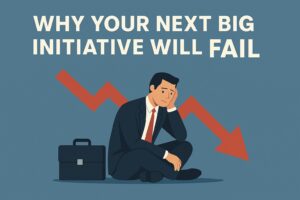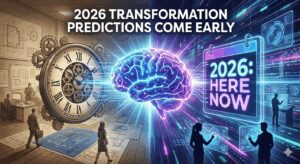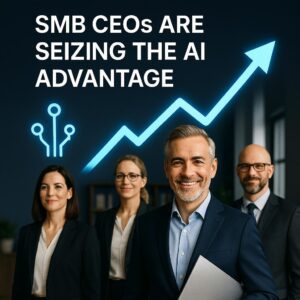
For Large SAP & Digital Transformational Programmes, a Rethink is Needed
EMERGENCY! STOP YOUR PROGRAMME NOW! Generative AI is changing everything !!
Introduction
This supplement to the first blog, “BizTech Change,” discusses the Why, What, and How (including the difficulties) of Large Transformational Programmes like SAP and Digital change.
The need for Business, Technology and Change to be embedded in each other is still required however an exponential change greater than the introduction of the Internet must be embedded with speed… this is Generative AI.
AI must be factored into every Programme and Project; it will change everything! If you are embarking on a large Programme this must be included or you will waste your money, be left behind and lead your business into a death spiral.
How will Generative AI affect my Programme/Project?
You are embarking on a large Transformational Programme, this may be Greenfield, Brownfield or Bluefield in nature and be a multi-country multi-year, probably based on Linear thinking, and using programme management methodology that is decades old ...HOWEVER, you are now facing an exponential technology ...Generative AI
Can you afford to take 4 or 5 years to find out that your programme is disappointing, used multiple £ millions only to find you are further behind your main competitors?
You must rethink your Programme and ask yourself: How do I embed this Generative AI technology into my Programme now?
How will Generative AI with its Large Language Models (LLMs) and Digital workers affect the following:
· Strategy formulation & execution
· Value chains & Value Streams
· Capabilities
· Target Operating Model (TOM)
· Processes
· Programme formulation & execution
· Etc
Because it will.
How do we apply Generative AI in our Business and Programmes/Projects?
1. Choose the correct Use Cases: Apply Generative AI to your “Golden” Use Case or Cases, you can’t afford to get this wrong or play at the edges, look for the biggest return on Value and protect your differentiation processes.
2. Build and use a portfolio of LLM’s including the following:
· Large Language Models (LLMs) like ChatGPT, Bing Ai, Bard, Claude etc for Productivity and efficiency gains.
· Fine Tune/Domain Specific models: Train LLMs on specific topics to become experts in these domains or acquire capabilities.
· Own Models: Based on your own data to gain new insights.
3. Automate Processes using Digital Workers: Automate processes where you can ( McKinsey “ 30% or more of all activities in 60% of occupations can be automated), massive productivity gains can be had by using intelligent software bots (Digital workers) on end-to-end processes / across processes and augmenting humans.
Digital workers are here to stay, you better get used to it!
Value Chains, Processes & Capabilities
How will AI affect Value Chains, Processes and Capabilities?
Your Use Case for AI is critical, you must get the “biggest bang for your buck”, you don’t have the time to get this wrong, and you must extract the most value from this strategic choice.
You must understand your Value Chains & streams, where Value is created, transferred, or lost, and where the constraints are in the Value Chain as this will give priority to the processes and capabilities that underpin the Value Chain, stream or stage that you might want to automate.
How to choose your Golden Use Case
This is not as easy as you think, £Billions are wasted on systems that only ever tackle symptoms and never get to the root cause of your problems, which leads to well-documented disappointments and failures.
We propose that you start with the Logical Thinking Process from the Theory of Constraints:
1. What are your Goals?
2. What are the problems in your Current Reality? (and importantly what are their Root causes)
3. Conflict Resolution (identify invalid assumptions on both sides as the gateway to break conflict)
4. Simulate the Solution (will the proposed solution overcome the problems in your Current Reality (on paper) don’t jump into a solution without this!
5. Implementation (what prerequisites/intermediate objectives are required to overcome obstacles on the route to achieving the main objective)
OK, we have logically identified a Use Case that will solve a major problem for us, however, will it deliver the best value for us?
The scope of the Value chain or chains (for the Use Case) must be discussed carefully and commitment from the leadership to the choice is essential.
Start by analysing your Ecosystem and understand your external stakeholders for the Value chain in question.
1. What is the Business Model in question and the external pressures on it?
2. Who are the stakeholders of note for the Value Chain?
3. Map the Value item exchanges between the Value chain and stakeholders (exchanges, expectations, and experiences)
4. What is the Value Proposition to your Customer?
5. What are your “North Star” measures?
6. What specific Strategic Capabilities need to be considered (Critical Success Factors)?
High-level business concepts like Strategy, Regulation, Processes, Employees, Policies & rules etc can be organised into Managing, Core and Supporting process categories grouped by their role in value creation for customers and support for business strategy.
This starts to form a Value Chain Concept Model (See Figure 1.0)
The primary focus of Core processes lies in customer-centric value delivery, as this is the primary source of revenue for the organization. These processes encompass everything from innovation to product and service lifecycle management.
Supporting processes, closely integrated with the core, provide vital support. These include fundamental activities like staff provisioning and the establishment of office systems, which are typically uniform across various organizations. As one moves further from the core, one can anticipate encountering more universally applicable, cross-industry processes.
Managing processes involves the planning and control activities managers utilize to optimize day-to-day core operations in real time. These are depicted near the core, distinct from the strategy and directional processes, which have their dedicated section.

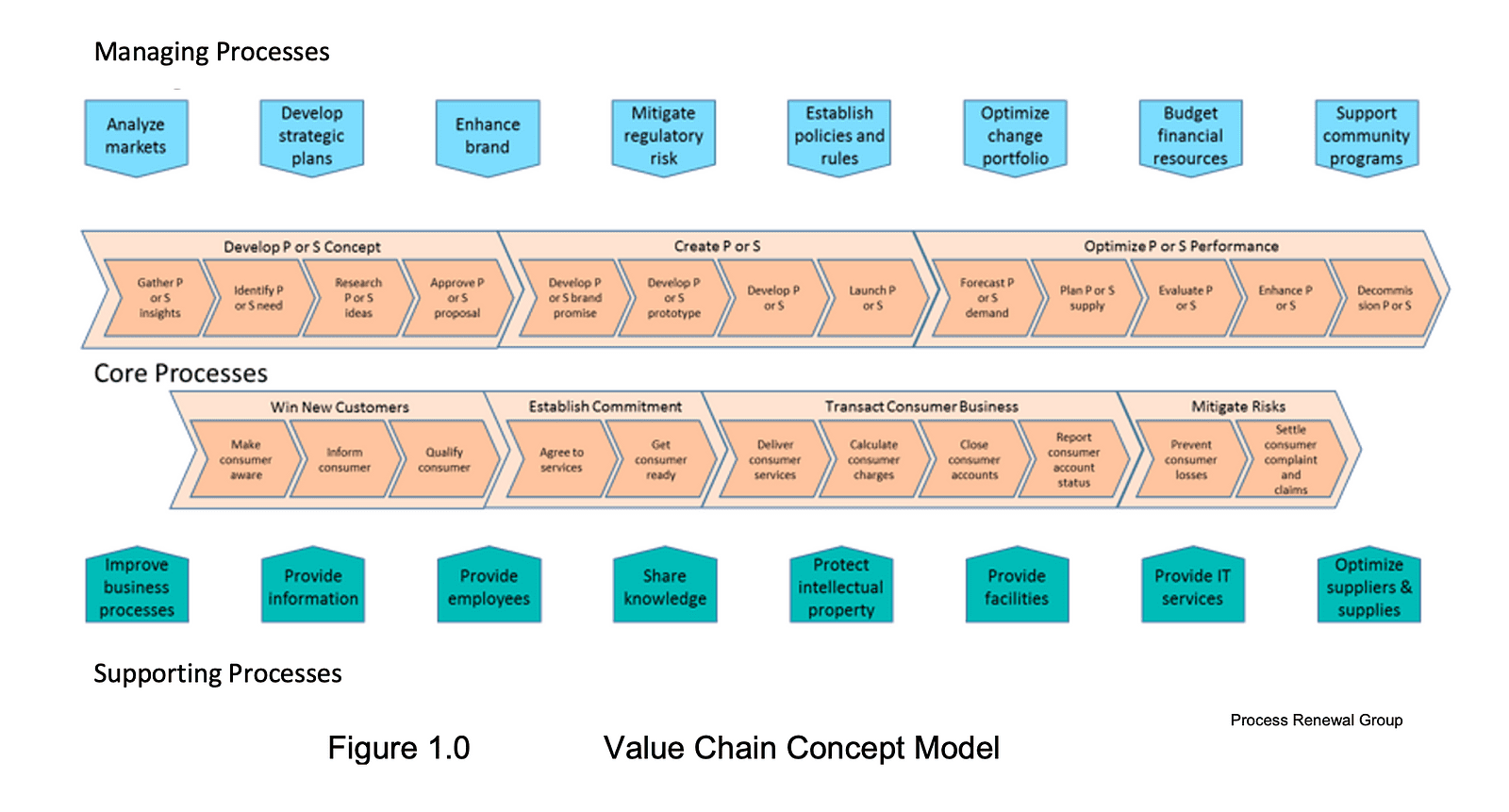
If we use an example of a Consumer Bank the Value Chain Concept model would be as follows:
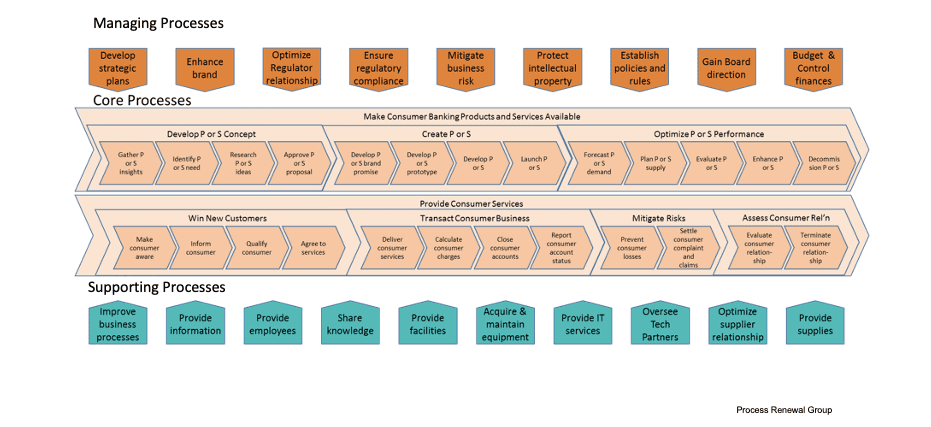
This is a High-level Value chain/stream which can have many levels.
Processes are mostly embedded/configured in our systems and augmented manually but need a business capability to run successfully, the relationship of processes to Capabilities is a many-to-many type with both being needed (See Figure 2.0)
We need to be capable, but we also must get the work done!
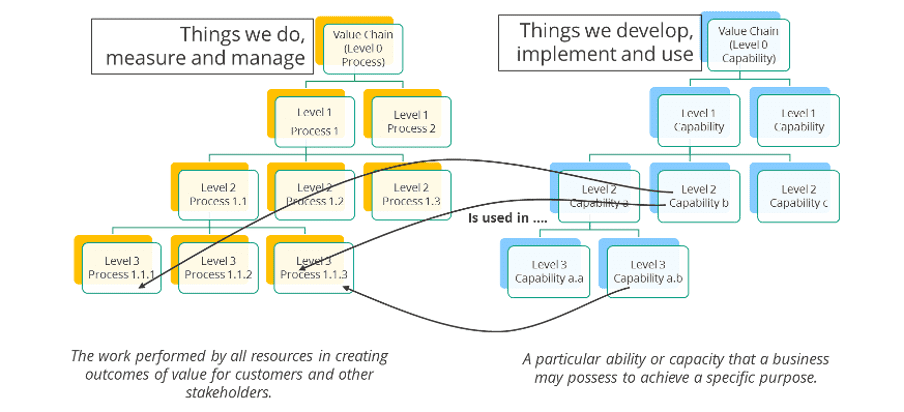
Process Renewal Group
Figure 2.0 Process Capability Relationship
Similarly, if we take our Consumer Banking example, High-level Capabilities can be grouped into Managing, Core and Supporting Capabilities
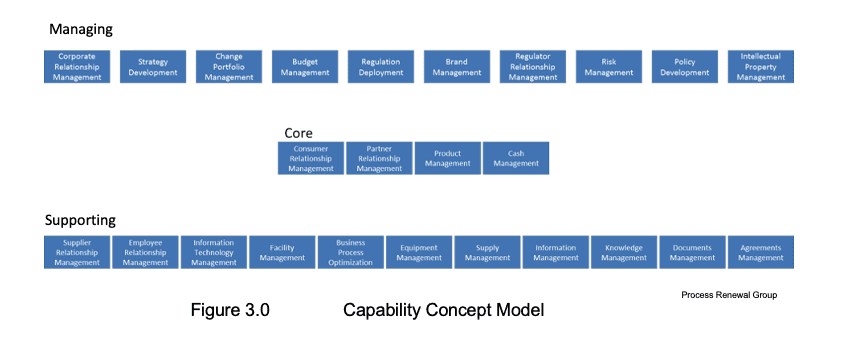
There can easily be hundreds of level 3 and thousands of level 4 capabilities. Rather than going deeper, it is more appropriate to do a top-level skeleton (capability map as shown in Figure 3.0) covering all the macro-objects as we did with the process architecture and only drill into the ones that we deem priority.
A sub-set of the previously shown Consumer Banking capability and process architecture maps and some of the connectivity between them is seen in Figure 4.0.
Note that a capability at any given level may affect several processes at any given level in the hierarchy.
Importantly, both views are required to work together to make the right changes happen, this includes impacts on the process operationally due to capability adjustments and capability changes required due to process improvement or innovations.
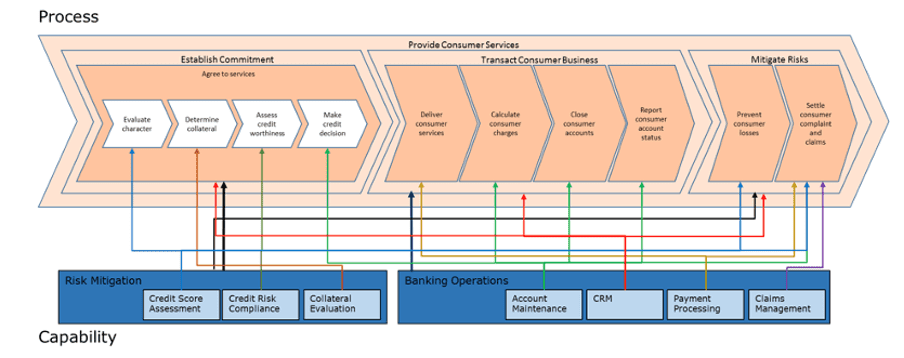
Process Renewal Group
Figure 4.0 Cross Mapping Processes & Capabilities
According to the Theory of Constraints, every process will have a “bottleneck” or constraint that governs the output of the entire process no matter what you do pre and post the bottleneck.
Applying a similar principle to a Value chain/stream, most of the Value will be generated by one or a few Value stages, this is the Value stream/stage you must concentrate on to achieve the most value being delivered. This Value Chain/Stream/Stage and its associated processes and capabilities are the ones to automate first!

Figure 5.0 Value Stream, Process & Capability Relationship
From Figure 5.0 suppose Value Stream 2 is in scope, and most value is generated at Value Stage 2.2, ask yourself the question “How do we automate the processes associated with Value Stage 2.2 and the Capabilities required to run those processes with digital workers and AI agents ?”
Differentiating/Signature and Commodity Processes
Looking at Processes through a different lens and identifying your Differentiation/Signature process/ processes, the processes that make you stand out in the market and give a competitive edge need to be protected for some time until you develop a new competitive edge.
Commodity processes are the ones that are similar to competitors in your industry and across most industries, these tend to be the ones carried out by Shared Service Centres & “ Centres of Excellence” that find their way to lower-cost countries or BPOs (Business Process Outsourcing companies).
Ask yourself the question:
“How can Generative AI help with my Differentiating and Commodity processes?”
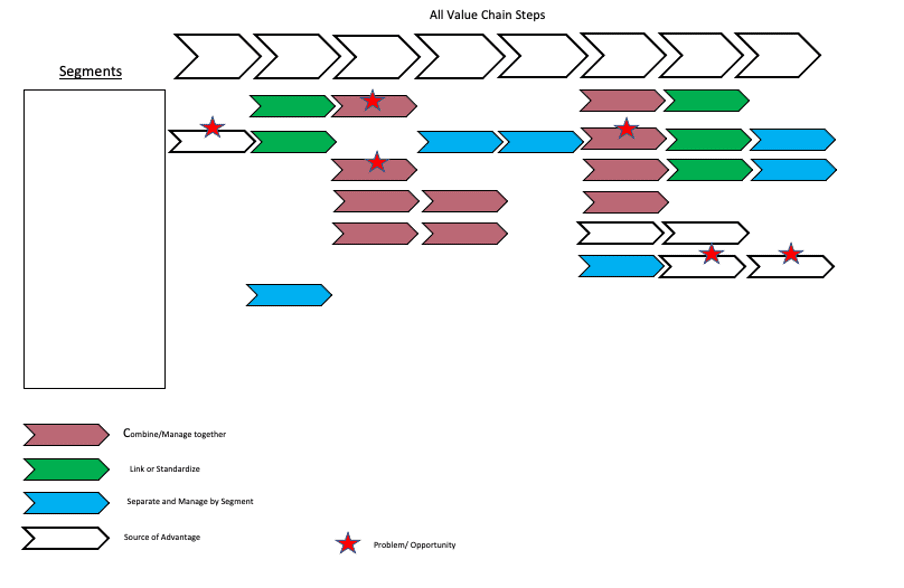
Figure 6.0 Differentiation & Commodity Processes
Similarly, we need to identify in our Value chains and streams our Signature/Differentiation Processes/Capabilities that are a source of advantage, or commodity processes/capabilities in Figure 6.0 and automate with AI Digital workers and agents.
The point is to automate the processes/capabilities (at whatever level) to generate the most Value! This is your Golden Use Case!
AI and Language Models
A large language model (LLM) is a powerful artificial intelligence system trained on vast amounts of text and code. It learns patterns and connections in language, enabling it to perform tasks like generating text, translating languages, answering questions, and summarizing text. LLMs have the potential to revolutionize how we interact with computers, making our lives more efficient and enjoyable.
Training an LLM involves two main steps: pre-training and fine-tuning. Pre-training involves exposing the model to diverse text data and training it to predict the next word in a sentence. Fine-tuning customizes the model for specific tasks, like question-answering or text generation.
LLMs offer various benefits, including improved communication, enhanced creativity, automation of tasks, personalized experiences, and gaining new insights. They find applications in industries like customer service, marketing, education, research, and entertainment.
They also contribute to better quality of life by enabling smoother technological interactions, providing accessibility features for individuals with disabilities, offering personalized content recommendations, and accelerating research and innovation.
However, LLMs come with challenges and limitations. These include potential biases in the data they learn from, ethical concerns regarding the generation of misleading content, high computational costs, environmental impact, and difficulties in understanding their decision-making process.
Looking ahead, the future of large language models involves advancements in model architecture, larger and more powerful models, continued fine-tuning for specialization, and integration of visual and audio data. They may also exhibit improved generalization and rely less on extensive training data for new tasks. Ethical considerations and responsible AI development will remain crucial in harnessing the full potential of large language models.
Large Language Models (LLMs) can be highly valuable in various aspects of business operations. Here are several ways businesses can utilize LLMs:
1. Customer Support and Chatbots:
· LLMs can power chatbots that handle customer inquiries, provide support, and offer information about products or services. This can significantly improve response times and customer satisfaction.
2. Content Generation:
· LLMs can automate content creation for marketing materials, including writing articles, creating social media posts, drafting emails, and generating ad copy. This saves time and resources for marketing teams.
3. Language Translation:
· LLMs can be employed for real-time translation services, allowing businesses to communicate effectively with international clients, partners, and customers.
4. Text Summarization:
· LLMs excel in analyzing lengthy documents and generating concise summaries. Extracting key points, important details, and relevant information enables users to quickly grasp the main ideas and insights from the document.
5. Personalized Recommendations:
· LLMs can analyze user data to offer tailored product or content recommendations, enhancing the user experience and potentially driving sales.
5. Market Research:
· LLMs can process vast amounts of text data to extract insights from customer feedback, reviews, and social media mentions, aiding in market analysis and trend identification.
7. Automated Email Responses:
· LLMs can draft responses to emails based on the content, allowing for quicker replies and more efficient inbox management.
8. Legal and Compliance:
· LLMs can assist in reviewing legal documents, contracts, and compliance materials for accuracy and adherence to relevant laws and regulations.
9. Data Analysis and Reporting:
· LLMs can assist in generating reports by summarizing data and providing key insights from large datasets.
10. Automated Documentation:
· LLMs can generate internal documents such as meeting minutes, project reports, or presentations, saving time for employees.
11. Content Moderation:
· LLMs can help filter and moderate user-generated content on websites, forums, and social media platforms, ensuring compliance with community guidelines.
12. Competitor Analysis:
· LLMs can analyze competitor websites, reviews, and marketing materials to provide insights on their strategies and customer sentiment.
13. Training and Onboarding:
· LLMs can assist in creating training materials, manuals, and guides for new employees, streamlining the onboarding process.
14. Customized Product Descriptions:
· LLMs can generate unique and persuasive product descriptions, improving the appeal of products on e-commerce platforms.
15. Voice Assistants and IVR Systems:
· LLMs can enhance automated voice systems for customer service, providing more accurate and natural interactions.
While LLMs offer significant benefits, it's important to consider potential ethical implications, including biases in data and content generation. Additionally, they should be used responsibly and complemented with human oversight where necessary.
Fine Tuned Models
Fine-tuning an LLM involves training on a specific data set to achieve better quality results, shorter prompts and refined capabilities.
The potential application of Business fine-tuned LLMs is vast with the potential of subscribing to fine-tuned models providing expertise and capabilities that you don’t have or industry-specific sets in a model portfolio.
Own Data Models
Another type of fine-tuned model would be based on your own data to provide insights that you don’t currently have.
The Rise of the Digital Worker
The Digital Worker is here, the intelligent software Bot and goal-based agents will have a massive impact on Businesses, automating both Differentiating and Commodity processes, augmenting Humans, and providing capabilities that were normally out of the Business's reach.
The Digital Workforce will plug the capability gap now, but the ability to add scarce and new capabilities at scale will give Businesses the opportunity to 10x their revenues while simultaneously reducing their costs…this is GPS (Growth, Profitability, Sustainability) Nirvana!
Your Vision, Creativity and “Kahunas” are the only constraints stopping you! But remember if you are not doing this at scale your competitors will!
Consider, for instance, that according to McKinsey & Company, 30% or more of all activities could be automated in 60% of occupations including:
69% of data processing activities.
64% of data collection activities.
81% of predictable physical activities.
The “Digital Worker” (the AI software Bot) goes way beyond the hard-coded RPA (Robotic Process Automation) rules-based digital business process with the intelligent ability to :
· Adapt
· Be scalable.
· Extend scope
The “Digital Worker” takes intelligent charge of your process and capability combinations and fuels Growth, Profit and Sustainability.
Establishing a Digital Worker
Establishing a digital worker involves several steps to integrate automation and artificial intelligence into your business processes. Here's a guide to help you get started:
1. Identify Processes for Automation:
· Identify your “Golden” Use cases, this could begin by identifying repetitive, rule-based tasks within your business that can be automated, but you want the most value generated so identify signature processes.
2. Define Objectives and Goals:
· Clearly outline the objectives you want to achieve with the digital worker. This could be improving efficiency, reducing operational costs, enhancing customer service, or achieving specific performance metrics.
3. Select the Right Technology:
Choose the appropriate automation and AI tools or platforms for your specific needs. Consider factors like compatibility with existing systems, scalability, and the complexity of tasks the digital worker will handle.
4. Data Preparation:
· Ensure that the data required for the digital worker to perform tasks is clean, accurate, and accessible. This may involve data cleaning, formatting, and integration from various sources.
5. Develop or Configure the Digital Worker:
Depending on your chosen technology, you'll either configure existing automation tools or develop custom software. This may involve programming, scripting, or using low-code/no-code platforms.
6. Integration with Existing Systems:
Integrate the digital worker with your existing software, databases, and systems. This ensures seamless communication and data exchange between the digital worker and other applications.
7. Testing and Validation:
Thoroughly test the digital worker to ensure it performs tasks accurately and reliably. This includes testing under various scenarios and conditions to identify and resolve any potential issues.
8. Security and Compliance:
Implement security measures to protect sensitive data and ensure compliance with relevant regulations, especially if the digital worker handles confidential information.
9. Training and Documentation:
Provide training for employees who will interact with or manage the digital worker. Create documentation outlining its capabilities, limitations, and troubleshooting procedures.
10. Monitoring and Maintenance:
· Regularly monitor the performance of the digital worker and address any issues promptly. Implement updates and improvements as necessary to keep it effective and efficient.
11. Scale and Optimize:
· Once the digital worker is operational, consider opportunities for further automation or expansion into new processes. Continuously optimize its performance based on feedback and data analysis.
12. Performance Evaluation:
· Regularly assess the impact of the digital worker on your business objectives. Evaluate its efficiency, cost-effectiveness, and contribution to achieving your goals.
13. Feedback Loop:
· Establish a feedback loop with employees and stakeholders to gather input on the digital worker's performance and make adjustments as needed.
14. Adaptability and Evolution:
· Keep an eye on emerging technologies and trends in automation and AI. Be prepared to adapt and evolve your digital worker to take advantage of new capabilities.
Remember that establishing a digital worker is an ongoing process. Regularly review and update your automation strategy to ensure it aligns with your business objectives and leverages the latest advancements in technology.
M&A
Businesses can grow substantially by buying or merging with other businesses, Capability leveraged, and Capability enhancement deals make up 74% of the Merger and Acquisition market ( 42% & 32% respectively) PWC.
A 3rd of all acquisitions are Capability enhancement types that give you a capability that you don’t have and want …but think with Generative AI and a combination of LLM (Large Language Models) and digital workers you could have that same Capability for a fraction of the Acquisition price!
Similarly, Generative AI (combinations of LLMs and digital workers) can provide you with additional capabilities that could be used for Capability leveraged deals.
Conclusion
We are in year 1 of the AI revolution, Chat GPT appeared only 12 months ago and brings with it the exponential change tsunami that has been forecast.
If you are embarking on a large Change programme and don’t factor AI implications into it, then you are DOOMED!
Within 12 months we will have AGI (Artificial General Intelligence) and along with that, we get a paradigm shift to 4IR (Fourth Industrial Revolution).
The Fourth Industrial Revolution will be greater than the 2nd & 3rd Industrial Revolutions put together maybe by a factor of 2, 4IR > ( 2IR + 3IR) and will bring the biggest set of changes ever in human history!
You need to get on board now! Start to use Large Language Models (LLM’s) and Digital workers/AI agents now!
This is the biggest opportunity a midsized company will ever get, to increase your revenues multiple times, reduce costs and fill capability gaps.
Don’t be a passenger or laggard in this game, 1st in WINs.
What to know more? Contact joe.cadden@techshifts.io
